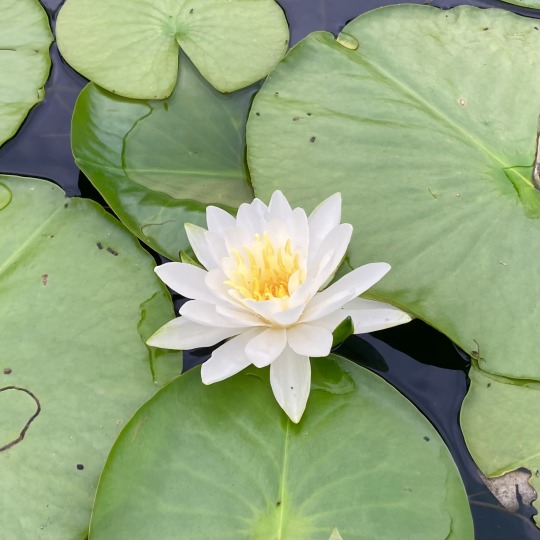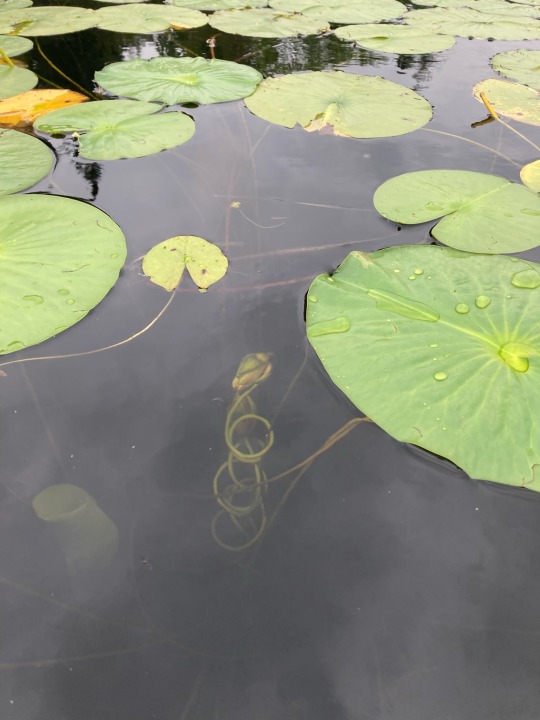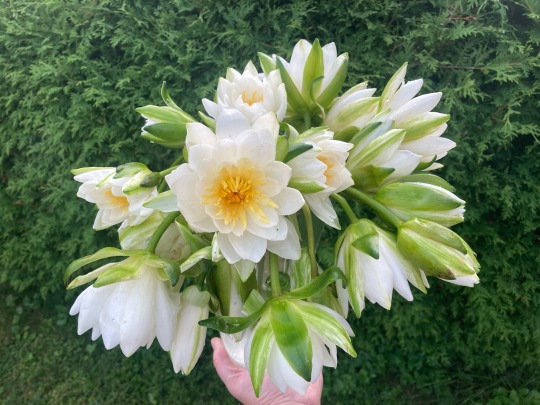#nymphaea odorata
Text







My adventures wild harvesting American white water lilies (nymphaea odorata) this summer for medicine and magic. Nymphaea odorata is native to North America and our local counterpart to blue lotus (aka blue water lily). It is used in Native American medicine to treat coughs, colds, and swelling. Prehistoric Native Americans associated them with purification, the underworld, and the moon.
You can dry and smoke the flowers or make medicinal syrups, tinctures, oils, and ointments with the roots and flowers. Water lilies are not a strong psychoactive. They need to be prepared similarly to lactucarium to make a concentrated extract like the blue lotus resins sold in head shops. That’s not what Bane Folk is about though (plus payment processors ban head shops). I focus on the medicinal uses of poisonous plants with special attention to ones that help with pain, sleep, anxiety, and depression. Water lilies fit that description perfectly.
Water lilies are sedative, hypnotic, anti-inflammatory (especially of mucous membranes and internal tissue), mildly pain relieving, anti anxiety, antibacterial, astringent, and demulcent.
Visit the apothecary to see my offerings of water lily medicines: banefolk.com
#bane folk#fragrant white water lily#beaver root#nymphaea odorata#nymphaea#waterlilies#poisonous plants#edible plants#medicinal plants#psychoactive plants
12 notes
·
View notes
Text

Unknown, White lotus, (Nymphaea odorata), Bengal, India, ca. 1800. Opaque watercolor on paper
303 notes
·
View notes
Photo

White Water Lily
“Nymphaea Odorata”
Nymphaeceae Family
#white water lily#white flowers#botany#botanical garden#flora#photographers on tumblr#photography#original photography#pretty flower#nice flower#good flower
7 notes
·
View notes
Text
Blog 01: My relationship with nature
Hi everyone, my name is Lea, and I am in my third year of Biological Science with a minor in Zoology. This first post is about my relationship with nature and how it has developed.
I have always felt I had a strong connection with nature and animals. I care deeply for the environment and the conservation of plants and wildlife. My love for nature all began at my cottage. My grandparents bought land along the water in a small town called St. Anicet, Quebec, on Lake St. Francois in their mid-30s. My grandpa had built a small cottage for our family to visit. I have lived a better half of my life at the cottage, every summer, every school break, every chance I had. At a very young age, my grandfather had taught all the kids how to fish and drive the boat and my cousins, and I were always free to go out onto the lake and discover what it had to offer.
I have so many unforgettable memories of kayaking with my older sister and little cousins across the lake to the many islands the lake provided. We always brought butterfly nets and insect kits with tiny magnifying glasses and caught bugs and frogs all day. We would also take the little fishing boat, go to different areas of the lake, and compare the size and type of fish we had caught. One of my favourite activities was going out on the canals, just off the lake, and simply looking at the white lilies (Nymphaea odorata) floating on the water.
The freedom to explore granted by my family helped me lean into my interest in nature. Going out and discovering different aspects of the lake on my own allowed me to observe the biodiversity and wildlife present. I grew up in Ottawa, specifically the Kanata area, a quiet suburb 20 minutes from the downtown core. Growing up in the suburbs felt significantly limiting in terms of being in touch with nature. My only relationship with nature was provided when my parents would drive outside of the suburbs to visit the different NCC parks and trails. These nature trails were not accessible to me growing up as they were too far to walk or bike, and I had to rely on my parents to drive. I believe that living in the suburbs definitely limited my connection, but having a cottage to visit was indeed an escape.
My current relationship with nature has developed over the years, from relying on my parents to take me to various nature trails to having the freedom to explore my interests on my own. As I have grown older, I have been able to do my own thing and visit new ecosystems. I enjoy going on hikes with my friends, and our favourite spot is definitely the Eagles Nest Lookout in Calabogie, just outside of Ottawa. I believe that I have given myself “a sense of place” because exploring on my own has improved my relationship with nature and allowed me to expand my interests.
Here are a few photos of me at my cottage & my favourite hiking spot :)




1 note
·
View note
Text

The 3 white-lily-plant (water lily) is an excellent plant with attractive white lily flowers. This plant is categorized under aquatic, flower plant & ornamental plants.
COMMON NAME: White lily plant (Water Lily)
SCIENTIFIC NAME: Nymphaea Odorata
FAMILY: Nymphaeaceae
SOIL: Clay soil
PLANT TYPE: Aquatic plant
ORIGIN: Eastern US
PLANT HEIGHT: > 6 inches
https://www.santhionlineplants.com/product/3-white-lily-plant-water-lily/
0 notes
Text
The American White Water Lily is Quite Beautiful
American White
One of our most common flowers in central Florida is the water lily. There are several different types and many of those types have different colored flowers, but one of the prettiest ones is the American white water lily (Nymphaea odorata). It can be found in most of North America and parts of Central America, so it’s not surprising that it also has several other common names…

View On WordPress
#American white water lily#beaver root#Florida water lilies#Florida wildflowers#fragrant water lily#fragrant white water lily#medicinal wildflowers#photography#summer wildflowers#sweet scented water lily#sweet scented white water lily#useful wildflowers#water lilies#water lily photographs#water loving wildflowers#white water lilies#white wildflowers#wildflower photographs#wildflower photography#wildflowers
1 note
·
View note
Text

20190808 MP294 Moses Cone Blue Ridge Parkway NC
Water-lily Nymphaea odorata
0 notes
Text
The 3 white-lily-plant (water lily) is an excellent plant with attractive white lily flowers. This plant is categorized under aquatic, flower plant & ornamental plants.
COMMON NAME: White lily plant (Water Lily)
SCIENTIFIC NAME: Nymphaea Odorata
FAMILY: Nymphaeaceae
SOIL: Clay soil
PLANT TYPE: Aquatic plant
ORIGIN: Eastern US
PLANT HEIGHT: > 6 inches
0 notes
Text
white-lily-plant
The 3 white-lily-plant (water lily) is an excellent plant with attractive white lily flowers. This plant is categorized under aquatic, flower plant & ornamental plants.
COMMON NAME: White lily plant (Water Lily)
SCIENTIFIC NAME: Nymphaea Odorata
FAMILY: Nymphaeaceae
SOIL: Clay soil
PLANT TYPE: Aquatic plant
ORIGIN: Eastern US
PLANT HEIGHT: > 6 inches
https://www.santhionlineplants.com
0 notes
Photo

Nymphaea odorata
VS
Carlo Scarpa and Arrigo Rudi, Banca Popolare di Verona, Verona, Italy, 1973-1981 © Jonathan Frantini
#Nymphaea#Nymphaea odorata#water lily#leaf#leaves#water lilies#waterlily#waterlilies#carlo scarpa#arrigo rudi#bpv#banco popolare di verona#verona#italy#italia#architecture#modern architecture#contemporary architecture#detail#window
41 notes
·
View notes
Video
On Golden Pond by jan buchholtz
Via Flickr:
A blurring of seasons as autumn gold reigns while summer refuses to die. Sheldon Lake State Park.Near Houston, Texas.
14 notes
·
View notes
Photo






Highland park waterlilies
6 notes
·
View notes
Text

“Everyday I discover more and more beautiful things. It is enough to drive one mad. I have such a desire to do everything, my head is bursting with it.”
- Claude Monet
#american white water lily#puremichigan#photography#photographers of tumblr#nature photography#original photography#amateur photography#michigan#nature#traverse city#boardman lake#boardman lake trail#cottagecore#naturecore#nymphaea odorata#n. odorata#flowers#fleetingfutures#mine#lily pads
1 note
·
View note
Video
undefined
tumblr
This place looks way different from when I first started coming in October.
#American white waterlily#fragrant water-lily#beaver root#fragrant white water lily#white water lily#sweet-scented white water lily#Nymphaea odorata#Plantae#Angiosperms#Nymphaeales#Nymphaeaceae#Nymphaea#water lilies#photographers on tumblr#nature photography#scenery#Samsung Galaxy 8#my video#Black Bayou Lake National Wildlife Refuge#flora#freshwater plants#flora of North America#flora of South America#invasive plant species
4 notes
·
View notes
Text
A Common Plant With An Odd Pollination Mechanism
Pollination is not an altruistic enterprise. Each party involved is trying to maximize its gains while minimizing its losses. Needless to say, cheaters abound in natural systems. As such, plants have gone to great lengths to ensure that their reproductive investments pay off in the long run. Take, for instance, the case of the fragrant water-lily (Nymphaea odorata).
Most of us have encountered this species at some point in our lives. Those who have often remark on the splendor of their floral displays. Certainly this is not lost on pollinators either. Coupled with their aromatic scent, these aquatic plants must surely be a boon to any insect looking for pollen and nectar. Still, the flowers of the fragrant water-lily take no chances.
Close observation will reveal an interesting pattern in the blooming cycle of this water-lily. On the first day that the flowers open, only the female portions are mature. The structure itself is bowl-like in shape. Filling this stigmatic bowl is a viscous liquid. After the first day, the flowers close for the evening and reopen to reveal that the stigma is no longer receptive and instead, the anthers have matured.
Many insects will visit these floating flowers throughout the blooming period. Everything from flies, to beetles, and various sorts of bees have been recorded. Seed set in this species is pollen limited so any insect visiting a female flower must deposit pollen if reproduction is to be achieved. This is where that bowl of sticky liquid comes into play. The liquid itself is rather unassuming until you see an insect fall in.
Due to the presence of surfactants, any insect that falls into the fluid immediately sinks to the bottom. The flowers seem primed to encourage this to happen too. The flexible inner stamens that surround the bowl bend under the weight of heavier insects, thus dumping them into the liquid below. Only by observing this process under extreme magnification does all of this make sense.
The liquid within the bowl essentially washes off any pollen that a visiting insect had stuck to its body. As the pollen falls off, it drifts down to the bottom of the bowl where it contacts the receptive stigma. Thus, cross-pollination is achieved. Most of the time, insect visitors are able to crawl out without any issue. However, the occasional insect will drown within the fluid. Alas, that is no sweat off the water-lily's back. Having dropped off the pollen it was carrying, it is of little use to that flower anymore.
Once a water-lily flower has been fertilized, its stem begins to curl up like a spring. This draws the ovaries underwater where they can develop in relative safety. It also ensures that, upon maturing, the seeds are more likely to find a suitable underwater site for germination. To think that this drama plays out time and time again unbeknownst to the casual observer is something I find endlessly fascinating about the natural world.
Photo Credit: [1] [2]
Further Reading: [1] [2]
30 notes
·
View notes
